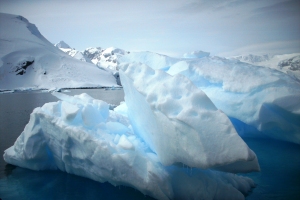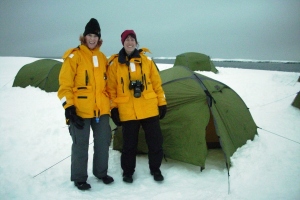ANTARCTICA: How I kept Warm in the World’s Coldest Climate–14 clothing items (gear) that worked
I received the assignment to produce a video in Antarctica for a polar expedition company (Quark Expeditions) with mixed emotions: thrilled about an adventure of a lifetime/ fear of freezing. The freezing part is justified: I have Raynaud’s disease, a medical condition defined as a hypersensitivity or allergy to cold that can cause hands and feet to discolor.
Being cold-challenged, I wear a sweater when entering a supermarket because the refrigerated sections make me shiver. Same with air- conditioned buildings. Snorkeling in Hawaii was impossible without a wet suit. Winters in Washington, D.C. froze me out with multi-colored hands, and for 10 years I bundled up on the beach in Los Angeles.
Antarctica? I have spoken the name of that continent maybe once in my life and turned blue. 
The subject of the mini-documentary was a tourist adventure expedition to Antarctica for 10 days that included land and water activities and encounters with penguins and seals.
With a little luck, drugs and a gown of down, I had hoped to survive the expedition to tell the tale and declare a victory over supermarkets.
I did extensive research about gear/clothing for extremely cold climate, but did not find a clear and detailed list. Finally, a week before the voyage and no clothes for it, I walked into an upscale ski store to be outfitted. I left with $800 (incl. tax) worth of layers/gear, not including the boots and parka (provided by the expedition company).


After 6 days in the Antarctic peninsula (South Shetland Islands), I can report that the gear worked to keep even me warm in some seriously cold weather.
How cold was it? Antarctica is an ice continent; the coldest, windiest, driest (and highest) one on Earth. It is gorgeous and mysterious, accessible to tourists only in summer. 
Although it was mid-November (summer), temps were mostly in the teens (F). But with wind chill from blizzards, some days were well below that. It got up to the 40s one day, a few days hit the 20s or teens without wind for a few hours, but mostly it was windy and snowy much like I imagine Canada in winter.
 Visiting 12 islands, I rode daily in a zodiac boat from ship to shore, went hiking in the snow, kayaked,
Visiting 12 islands, I rode daily in a zodiac boat from ship to shore, went hiking in the snow, kayaked,
 camped overnight in a pup tent on ice and snow during a blizzard, visited a couple of scientific research stations, took zodiac tours of glaciers and icebergs;
camped overnight in a pup tent on ice and snow during a blizzard, visited a couple of scientific research stations, took zodiac tours of glaciers and icebergs;
 and spent hours following, observing and photographing penguin colonies, seals and birds. Regardless of the weather conditions and activities,
and spent hours following, observing and photographing penguin colonies, seals and birds. Regardless of the weather conditions and activities,
THE CLOTHES WORKED TO KEEP ME WARM!
From someone with Raynaud’s disease in Antarctica, this is the list of clothing to know about because it all worked in sub-zero temps.
Keeping warm starts with 3 layers and the unique fabric technology of each layer.
1. Base Layer (top/bottom): warm-wear moisture transfer fibers (MTF)
The MTF base layer is a patented knitting fabric that fits like second skin. It’s a tightly knit polyester micro fiber blended with Lycra. The MTF yarns create a weather barrier to keep you warmer and dryer because moisture from perspiration gets dispersed and evaporated quickly. Looks like tights; is machine wash/dry.
(retail: $55/each, top/bottom)
2. Mid layer (top/bottom): Thermolite fiber technology (95% polyester, 5% Lycra)
Thermolite is soft, flexible, durable insulation for movement and warmth. This is a slightly heavier layer than the base layer, yet thin. The inside of the fabric feels soft and warm; the outside is smooth. The top piece has a half-zipper to pull over the head. This layer can also be worn alone, but on top of the base layer the two kept me very warm. Machine wash/dry. (retail: $79 each, top/bottom)
3. Outer layer: waterproof/windproof/durable layer worn over the mid layer (ski pants, parka)
a) Ski pants: Gore-Tex fabric: shell 100% polyester; lining 80% polyester/20% nylon; insulation 100% polyester
The lightweight ski pants didn’t restrict movement. Gore-tex 2-layer shell: a thin, soft polyester lining inside and a thin, sturdy outer shell. The pants have features: expandable waistline, brushed tricot pocket liners for warmer hands, waterproof leg zippers, zippered cuff bottom openings in the legs with inner boot gaiters with elastic gripper to help prevent water from getting up. My legs were kept warm and dry getting in and out of zodiacs and in blizzard conditions. Machine wash/dry (retail: $279)
b) Parka: 100% thick nylon outer shell, 100 % polyester (fleece) inner jacket with 100% nylon outer top
This is such a crucial garment that Quark Expeditions refers to it as a “piece of equipment for the polar regions, not a fashion statement.” Quark manufactures and provides the parka to each passenger complementary. It can also be purchased from their Website.
It’s a 3-in 1 miracle of construction that ensured my survival. Long enough to cover my butt when sitting in the zodiac, the parka is lined with a zip-in-out fleece jacket liner that doubles as insulation and also as a stand-alone fleece jacket in warmer weather (40s or higher). The outer yellow shell of thick nylon with lined hood and neck straps was fully waterproof/windproof. Without the jacket lining, it serves as a water-windproof jacket. The entire “piece of equipment” is loaded inside and out with pockets, zippers, Velcro fasteners, snaps, hook rings. (from Quark: $250)
4. Foot layers (sock liners, socks, boots)
a) Sock liner: Thermasilk fabric (80% spun silk, 20% stretch nylon)
This thin, light, soft fabric sock comes just under the knee. Wash/wear (retail: $12/pair, 2 pair)
b) Socks: SmartWool fabric (a wool-on-wool Duroyarn fabric technology).
My feet, including toes, were kept warm and dry. Machine wash/wear (retail: $21-26/pair, 2 pair)
c) Boots: Quark loaned these to each passenger for the duration of the voyage because boots are indispensible. They were lined, rubber, sized boots that came up between calf and knee. (from Quark: $140)
5. Hand layers: Gore-Tex storm-proofing
a) Glove liner: Dryride Thermex fabric, 4-way stretch with sticky grip palm.
The thinner liner was warm enough to wear by itself for short periods of time (like when taking photos)
b) Gloves: Gore-tex 3-in-one fabric for sub-zero conditions with top zipper pocket for a hand-warmer. I needed gloves with fingers, which are not as warm as mitten style gloves. Even with the glove liner, hands got chilly at times because I forgot to take glove warmers to put in the top zippered pockets. (retail: $65/liner and gloves)
6. Neck: 100% acrylic neck warmer worked perfectly to keep out wind. Machine wash/dry (retail: $12).
7. Head: 100% acrylic snug -fitting hat to forehead that covered ears worked well. Machine wash/dry (Retail in Ushuaia: $7).
8. Eyes:
In blizzard conditions, I wore goggles with interchangeable silver/amber lenses for brightness and they kept snow and wind out of my eyes. (retail: $65). Otherwise, I wore a pair of plastic, full UV-protection sunglasses, or nothing some days.
9. Camera: a DrySac or moisture protector was needed for expensive camera equipment. Cameras with lithium ion batteries did fine. Unfortunately, I had a digital camera that used AA batteries. They kept freezing so I was unable to take many photos. Same problem with the mini video camera. But I did have some luck:
See photos of Antarctica:
http://www.picasaweb.google.com/hawaiikaren
See video of penguins:
See guerilla video of Antarctica:
View the mini-documentary about the expedition:
to return to website: http://www.multi-mediaworks.com
September 14, 2011 at 11:59 pm
loved the info thanks im using it for my research and citing your name 🙂
December 30, 2015 at 9:58 pm
That synthetic gear is for summer. 40′? That’s warm to Alaskans. If you wear that synthetic stuff in Antarctic winter you would freeze. For extreme cold like -60’F and below, you need things like Bata white bunny boots and 1″ or more wool felt insulated clothing.
July 13, 2016 at 12:05 pm
Thank you for info. Yes, this was Springtime in Antarctica (November)
July 13, 2016 at 12:05 pm
Great, thank you!